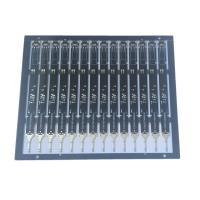4 Layer PCB 1.6 MM Thickness 1 OZ Copper Black Solder Mask
1 4 Layer Printed Circuit Board PCB .
2 Immersion Gold treatment, gold thickness 1u'.
3 FR4 substrate material, tg150 degree.
4 Min line space and width 3.5/3.5mil.
5 Copper thickness is 1 oz on each layer, 35 um on each layer.
6 Black solder mask and white silkscreen.
7 ROHS, MSDS, SGS, UL, ISO9001&ISO14001 Certificated
| Our Product Categories |
| Material Kinds | Layer Counts | Treatments |
| FR4 | Single Layer | HASL Lead Free |
| CEM-1 | 2 Layer/Double Layer | OSP |
| CEM-3 | 4 Layer | Immersion Gold/ENIG |
| Aluminum Substrate | 6 Layer | Hard Gold Plating |
| Iron Substrate | 8 Layer | Immersion Silver |
| PTFE | 10 Layer | Immersion Tin |
| PI Polymide | 12 Layer | Gold fingers |
| AL2O3 Ceramic Substrate | 14 Layer | Heavy copper up to 8OZ |
| Rogers, Isola high frequency materials | 16 Layer | Half plating holes |
| Halogen free | 18 Layer | HDI Laser drilling |
| Copper based | 20 Layer | Selective immersion gold |
| 22 Layer | immersion gold +OSP |
| 24 Layer | Resin filled in vias |
Q1: What is a 4-Layer PCB Stackup?
A1: A 4-layer PCB Stackup is a multilayer PCB that consists of
multiple layers of copper and insulating materials stacked one
above the other. For maximum efficiency and minimum losses and EMI,
it is important to plan the right stack up of layers before
starting the fabrication process. 4-layer PCB is the most common
stack-up arrangement used in modern electronics.
A 4-layer PCB stack up consists of top and bottom layers, a core (copper-clad
layer), and an insulating layer also called prepreg made of a dielectric material like glass fiber/weave cloth. The
top and bottom layers are made of copper foils, which are then
laminated and etched to create slots for mounting the components.
The core layer is made up of prepreg sandwiched between two copper
foils. These top and bottom layers, core layer, and prepreg are
bound together in such a way that no air is trapped between them.

As mentioned in the previous paragraph, the 4-layer PCB comprises
the top and bottom layers, prepreg and a core layer. Now, the top
and bottom layers, made of copper foils are used as signal planes.
After lamination, the desired slots are etched for the placement of
components and vias, which are electroplated holes connecting
different planes in the PCB. The top side of the core is used as a
ground plane, while the bottom side is used as a power plane. To
reduce EMI and crosstalk, it is advisable to place the ground plane
above the power plane. This will help in the reduction of
overlapping and interference of the magnetic fields created by the
signal and the current planes. The ground plane also helps in
routing the return current and dissipation of heat.








